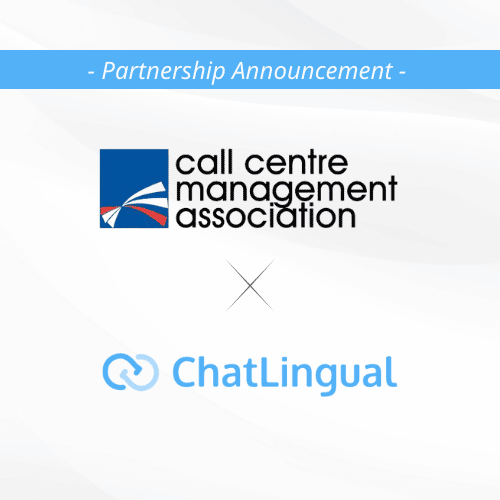Famed business strategist Roger Martin, a former dean of the Rotman School of Management at the University of Toronto, has advocated for a new approach to managing contact centers (or “decision factories” as he calls them). He argues the cycle of scaling staff is not only inefficient — especially hiring for positions that recently turned over — it stifles and prevents an experienced workforce from sharing institutional knowledge that gives the brand the stability it needs to innovate and push the envelope.
As far back as 2014, 86 percent of respondents to an International Customer Management Institute survey said they had customers who are not native English speakers.
Call center agents feel this pinch especially hard as more of their knowledge is used to develop algorithms and applications that replace them in their non-native-language markets. What if, instead, these tools solved businesses biggest outstanding problems, such as:
- Growing and retaining a global customer base
- Retaining institutional knowledge among frustrated workforces in a time of major resignations
- Inter-departmental collaboration and internal communications among a global workforce
Contact center managers struggle against leadership’s calls to implement automated systems that sink customer satisfaction and alienate those within and without the organization who do not speak the center’s primary language.
More call center managers and customer experience professionals are activating their agents’ abilities with platforms, software, and artificial intelligence to attract new customer orders, impact employee retention, and expand the reach of IT and human resource departments across decentralized workforces. The solutions discussed in this document when enacted by a global Fortune 500 company raised its agent net promoter score from -55 to +88.
Chatbots Aren’t Smart Enough to Replace Human Support … Yet
Chatbots with multilingual abilities offer their adopters an increased global reach, to be sure. These virtual assistant applications are powered by machine learning algorithms capable of understanding human language and answering inquiries with multiple choice selections based on the algorithm’s understanding of the user’s intentions. A revolutionary technology with numerous applications, for sure, so it is no mystery why so many brand leaders put their faith in these technologies to perform what are perceived to be mundane customer service requests.
Virtual assistants began taking a larger share of the marketplace within the last 10 years as brands began to advance their global scale ambitions and sought a way to provide support without raising overhead costs. What they got are the chatbots many of us know today that use hierarchical and relational maps to answer customer inquiries. Most of these applications scan the user’s question for keywords or “search strings” the bot has stored within its databases.
Sometimes these applications are a quick and easy way to provide basic customer service in many languages. The trouble starts if the user has a more technical question or asks for something with phrases the algorithm does not recognize. In these scenarios, instead of a live agent talking through the issue with the customer, the bot often presents the user its best guess or simply refers them to a frequently asked questions document with the hope the inquiry resolves itself.
In its annual report on the state of global customer service, Computer Generated Solutions (CGS) noted its survey of North American and European consumers who believe the move to fully automated services has been rushed to the point that customers are not finding the solutions they need in its wake.
Consumers expect speed, not a cookie-cutter approach for their personal or complex issues, the report says. Consumers give up on chatbots and reach out to humans instead when the issue is too complex or when the bot simply redirects users to the brand’s FAQ document. The global business advisory group recommends brands instead leverage new technologies for process improvement and to “empower human agents to address complex or unusual issues by hiring people with the right skills and providing ongoing technical training.”
In discussing the survey with Forbes magazine, Michael Mills, CGS’ senior vice president for contact center issues, says humans are better suited – and more trusted by consumers – to handle technical or personal questions. In fact, there are some inquiry types, such as personal health care, where a consumer trusts a human agent over a chatbot.
“The rationale being that a live agent can react and adapt to the complexity of that individual’s problem and resolve the issue,” Mills said. “Artificial intelligence programs and self-service applications are only as valuable as the information that resides inside their databases.”
Automated chatbots are only as good as the information within them and the data they have studied beforehand.
Chatbots are powered by algorithms that study datasets with clearly defined parameters. Eventually, the parameters go away and the machine uses what it has learned to predict an outcome. This is a constant process for machines, so their predictions become more and more informed. It is not unlike learning a new language with flashcards.
Most translator bots try to mimic the human mind and the many connections it makes to form what is called a “neural network.” Like the human brain, a machine developing a neural network is attempting to make a map of all the connections it associates with the data provided by the user. The more data the machine reads, the more likely it is to provide a correct answer.
Eventually, machines engage in these processes on their own. For now, Layla El Asri, a research manager at Microsoft Research Montreal working to improve how machines interact with language, says the technology still needs more human supervision.
“When it comes to dialogue, you need to learn how to make a sentence that is grammatically correct, and then you need to learn how to make a sentence that makes sense in the global context of the dialogue or a sentence that brings new information in the dialogue that is going to make the person you are talking to satisfied with the sentence,” Asri says on a Microsoft-produced podcast. “Your action space is just huge because it’s not just up/down, right/left, it’s all the sentences you could imagine!”
Machine learning has already transformed the way human and computer interact with one another, but there are still moving barriers that require an agent to intervene before the applications they power can be left to their own devices. Just like it would be unwise to leave a new employee unsupervised and expect them to provide well-informed customer service, these machines still need time to understand the brilliant complexity of language.
Hybrid Support Expands Brand Reach without Sacrificing CX
Scaling a contact center with enough agents to meet global language demands is unattainable for most organizations. Doing so requires iron-clad employee retention, an easily accessible, diverse talent pool, scalability to accommodate seasonal demands, and the foresight to have enough agents who speak the languages most needed as the brand enters new markets – which is not always predictable. These demands and ever-changing factors are too much for any Human Resource team to manage.
Not offering translation support creates barriers between departments and the employees within them. Human resources representatives, information technology teams, and, of course, the contact center agents are turning to free translation services online and all the pitfalls therein, including the likelihood for a botched interpretation.
More than 40 percent of consumers prefer live chat over voice support. For many companies, live-chat and other digital solutions enable a more efficient and scalable support strategy than voice support, especially in markets with an otherwise unsupported language. For these reasons, your strategy for support scalability should probably include live-chat tools.
Hybrid solutions solve the challenge of scaling multilingual support by doing more than adding a chatbot to the customers’ support journey in advance of sending them to voice support. Ideally, these solutions reduce businesses’ reliance on voice support dramatically and empower agents to support live chat in many languages with a combination of a database of knowledge about the business and customer FAQs as well as translations.
As brands around the world increase their presence on digital channels, the transition to digital contact centers takes priority. This cloud-based customer engagement environment gives customers more choice than ever before, and it is a CX tool that is likely to continue trending.
Multilingual Support Increases Employee Retention as Well
Customers are not the only ones speaking the contact center’s primary language. They also are not the only key stakeholders who would rather connect with the brand, its employees, and customers in their native language. Keep in mind that you will not retain employees who are constantly frustrated by trying to support customers beyond their primary language.
A significant portion of the labor force went remote over the past two years, which means they have more job opportunities than ever. In April 2020, roughly 47 percent of all workers in the United Kingdom said they work from home in some capacity. Around the same time in the United States, 70 percent of the workforce was working remotely at least 10 percent of the time. Although the COVID-19 pandemic certainly forced employers to adopt a remote-work policy, 76 percent of remote workers say their employer will allow them and their colleagues to continue working remotely in some form from here on.
The new remote workforce and the resulting job opportunities will increase the likelihood for a more diverse workplace. That is something to celebrate, but managers need to prepare for it in order to stay competitive and attract top talent. With geographic boundaries less of an employment condition, that talent may not be native English speaking and they most likely will not be engaging with their co-workers and supervisor in-person. This means leaders must ensure internal “customer” support, the support you provide employees, is comprehensible for all employees as well.
This is ideal for support leaders who wish to reduce overhead — they no longer have to build and staff support centers for language. Teams supported by human-backed language support software may now be located in places where skilled talent pools meet low operational costs, not just where the native-language speakers live.
Your New Employee & Customer Support Metric: Comprehensibility
Proving the effectiveness of a new communications plan is not an exact science, and there are numerous ways organizations choose to analyze them.
For instance, engagement metrics that rely on the brand’s revenues performance. A collaborative team is a profitable team, or so the theory goes. The problem with relying on revenues to determine productivity, customer satisfaction, and inter-departmental collaboration is it forces the surveyor to make a few assumptions about economic situations and that each unit has a direct connection to profit.
Another methodology looks at the enterprise’s employee turnover rate. Although a more effective measurement than market performance, there are also numerous variables at play. Even before the great recession, employee tenure was in a steady downturn. In support, turnover is expected due to seasonal considerations or the temporary nature of the work.
The University of Texas at Austin’s Institute for Organizational Excellence encourages human resource managers to routinely administer a Survey of Employee Engagement (SEE) to their employees, and use the composite score to measure collaboration and overall satisfaction with the brand’s work environment. The questionnaire asks respondents to grade their agreement with statements such as:
- “My work group cooperates to get the job done.”
- “I know how my work impacts others in the workplace”
- “In my work group, there is a real feeling of teamwork.”
Over time, these graded responses tell a story of attitudes throughout the enterprise, identify barriers within each department, and even give an overview of how likely a unit is to connect with its counterparts throughout the organization.
What really matters is who comprehends the company’s directives, from employees to potential customers.
If you focus on comprehensibility as the measure of interpretation quality, your non-native language support metrics are guaranteed to improve. To get there, you need a way to discern how well your employees understand organizational messages as well as how well an agent and customer understand one another within the context of the conversation.
How Comprehensibility Factors into Multilingual Employee & Customer Experiences
- Machine Translation: The least expensive and also least comprehensible translation tools generally focus on translating the word, not the meaning.
- Human Interpretation: Comprehensibility tends to be greater, however bilingual agents may be more costly than artificial intelligence.
- Canned Responses: A knowledge base of FAQs can help ensure responses in any language are more comprehensible, consistent, and on-brand than if you use only machine or human translation.
- Combined Approaches: Empowering agents with a knowledge base of answers to FAQs while also putting human-backed machine translation at their fingertips results in the highest comprehensibility scores.
ChatLingual provides instant translation between more than 100 languages with a comprehensibility rate of 97 percent. With comprehensibility rates of that magnitude, any contact center agent can become a multilingual agent.
For the best results and to ensure multilingual customers are getting the support they need, ChatLingual suggests brands direct consumers to live chat support as opposed to a call center. Not only does this conversion allow multilingual translators to interpret messages between the agent and the customer, but it also allows the brand to provide support outside of normal business hours and for the agent to provide a transcript of the conversation after the transaction is complete. There is also less of a need to direct customers through an elaborate phone tree to find support from another division or a need to transcribe and store recorded phone calls “for quality assurance and training purposes.”
Take the frustration out of connecting customers and employees with native-language, live-chat support with ChatLingual’s seamless integration of the contact center software Agent Success Platform with your Customer Relationship Management (CRM). On-boarding service will have contact center agents speaking fluent ChatLingual within six weeks.
At face value, this seems like an investment in customer service management. In depth, this is the kind of support Customer Experience (CX) professionals need to feel a sense of validity in their work. It gives them broader reach to parts of the organization previously out-of-reach, and shows the enterprise how committed the brand is to creating an accommodating customer journey.
Schedule a demo today to discuss how we can help you scale your support into any of your non-primary language markets.



